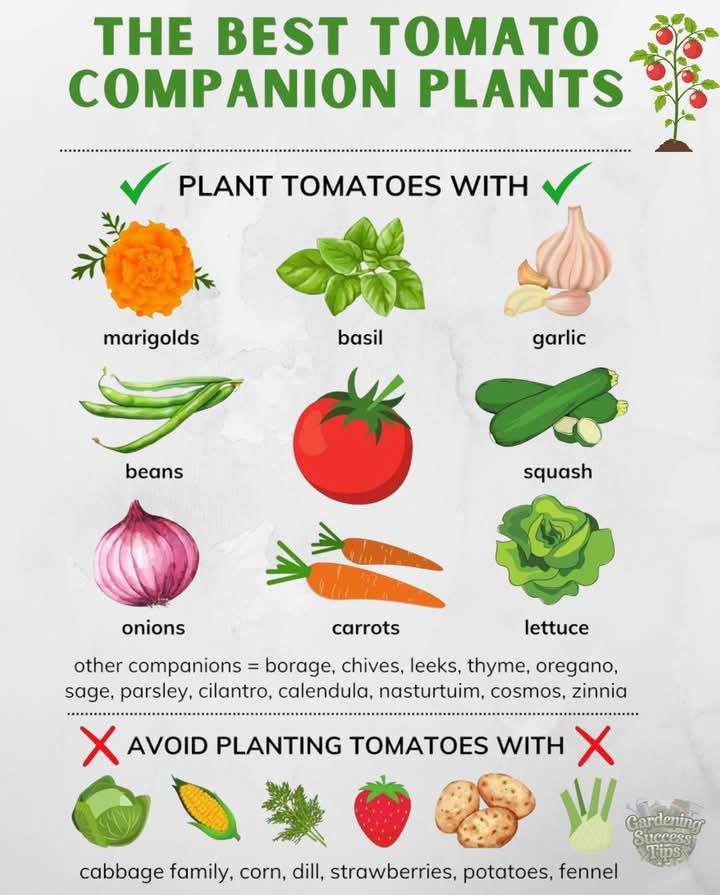Tomatoes thrive not only on care, sunlight, and water, but also on good garden companionship. Just like in human relationships, some plants make great neighbors for your tomatoes, while others can cause issues. Let’s dive into which plants can help boost your tomato harvest and which ones you should avoid!
1. Plant Tomatoes With:
🌼 Marigolds – Repel Pests Marigolds are a fantastic companion for tomatoes because they help repel pests like aphids, whiteflies, and nematodes. Their scent confuses insects, keeping your tomato plants safe from common garden pests. Plant marigolds around the base of your tomato plants for natural protection.
🌿 Basil – Boosts Flavor & Growth Basil isn’t just a tasty herb to pair with tomatoes in your meals—it’s also a great companion plant. Basil has been shown to improve tomato flavor and stimulate growth. Additionally, it helps repel insects like mosquitoes and flies. Growing basil near your tomatoes encourages a healthy, vibrant garden and enhances the taste of your homegrown tomatoes!
🧄 Garlic & Onions – Natural Protection Garlic and onions can help keep unwanted pests away from your tomatoes. These plants emit strong smells that deter insects and even certain diseases. Plus, they don’t compete with tomatoes for nutrients. Plant garlic or onions near your tomatoes to boost natural pest control and keep the soil healthy.
🍃 Beans, Lettuce, Squash, Carrots – Harmonious Garden Companions Tomatoes grow best when planted alongside beans, lettuce, squash, and carrots. These plants create a harmonious garden ecosystem:
Beans provide nitrogen to the soil, enriching it for your tomatoes.
Lettuce grows quickly, allowing you to harvest it before it competes for space.
Squash spreads out and provides ground cover, keeping the soil moist and reducing weeds.
Carrots have deep roots, allowing them to coexist with the shallow roots of tomatoes without competing for nutrients.
🌿 + Extras:
Borage: Attracts beneficial insects, improves tomato flavor, and deters pests like tomato hornworms.
Thyme: Repels harmful insects and supports pollinators.
Parsley: Acts as a natural pest repellent and attracts beneficial insects.
Calendula: Repels aphids, beetles, and other pests, while attracting pollinators.
These plants all support the health and productivity of tomatoes, so consider mixing them into your garden layout.
2. Keep Tomatoes Away From:
Some plants just don’t get along well with tomatoes. They can stunt growth, attract pests, or compete for nutrients, making them less-than-ideal neighbors. Here’s what to avoid:
🥬 Cabbage Family (Cabbage, Kale, Broccoli, etc.) Tomatoes and members of the cabbage family (brassicas) don’t mix well. They can compete for space, water, and nutrients, leading to stunted growth for both plants. In addition, cabbage family plants can attract pests like aphids and cabbage worms, which may target your tomatoes too.
🌽 Corn While corn and tomatoes might seem like they’d grow well together, they don’t. Corn can shade tomatoes and take up a lot of space and resources, leaving your tomato plants with insufficient sunlight and nutrients. Corn is also a magnet for pests like the corn borer, which can harm tomatoes as well.
🌿 Dill & Fennel While dill and fennel are aromatic herbs that can be beneficial in other parts of your garden, they’re not great companions for tomatoes. Both plants can inhibit tomato growth by releasing compounds that interfere with tomato roots. Dill, in particular, can attract pests like aphids that also damage tomato plants.
🍓 Strawberries Tomatoes and strawberries don’t grow well together due to competition for space and nutrients. Additionally, strawberries can attract slugs and snails, which are also fond of tomatoes. It’s best to plant them in separate areas of your garden to avoid these issues.
🥔 Potatoes Tomatoes and potatoes are both part of the nightshade family, but they don’t make good neighbors. Planting them together increases the risk of spreading diseases like blight. Both plants are susceptible to the same pathogens, so keeping them separate is crucial for disease prevention.
Final Thoughts:
To grow healthier tomatoes, it’s essential to choose the right companions. Pairing your tomatoes with plants like marigolds, basil, garlic, beans, and carrots will promote healthy growth, pest control, and improved flavor. On the other hand, avoid planting tomatoes next to cabbage, corn, dill, fennel, strawberries, or potatoes to prevent competition and disease. By thoughtfully planning your garden’s plant relationships, you can enjoy a bountiful, healthy tomato harvest this season! 🌿🍅
More Articles You Might Like
-
Texas Toast Sloppy Joes: The Crunchy, Cheesy Upgrade You Didn’t Know You Needed
There’s something timeless about sloppy joes. For generations, this saucy, savory, and slightly sweet ground beef sandwich has been a go-to comfort food in American kitchens. It’s quick, filling, and family-friendly—perfect for busy weeknights. But what if we told you there’s a way to take this classic dish up a notch? Enter the Texas Toast…
-
Classic Pig Pickin’ Cake
When it comes to Southern desserts, few sweets shine as brightly as the Classic Pig Pickin’ Cake. This nostalgic cake, sometimes called a “Mandarin Orange Cake,” has roots deep in Southern tradition. It gets its playful name from its frequent appearance at pig pickin’s—Southern-style barbecue gatherings where communities come together to enjoy slow-cooked pork, sides,…
-
Lemon Garlic Butter Chicken with Creamy Parmesan Pasta
There’s something irresistible about the combination of tender, golden-browned chicken paired with a creamy pasta coated in Parmesan cheese. Add the brightness of lemon, the depth of garlic, and the richness of butter, and you have a recipe that feels indulgent yet approachable enough for a weeknight dinner. Lemon Garlic Butter Chicken with Creamy Parmesan…



